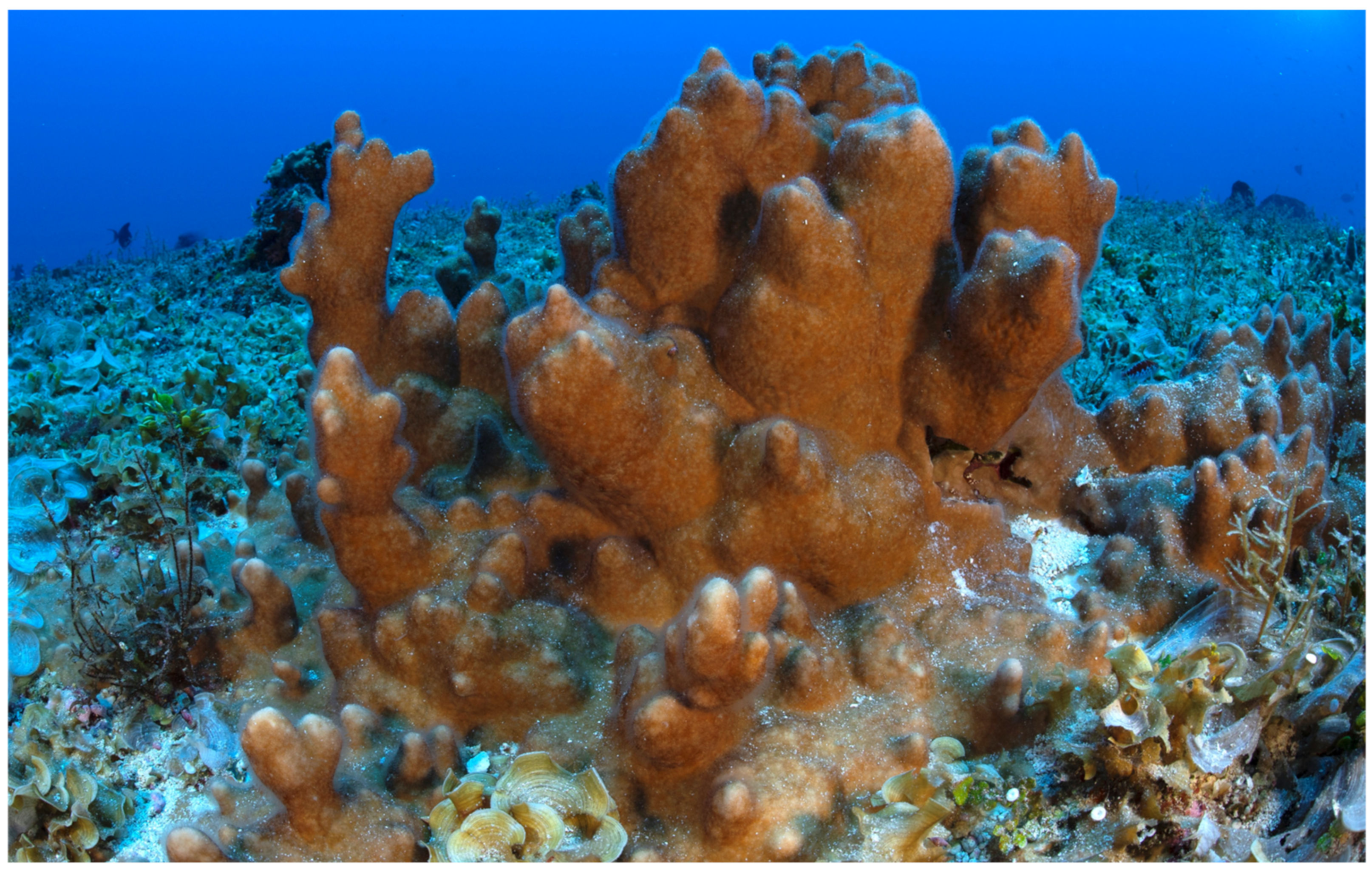Millepora aff. exaesa (Cnidaria, Hydrozoa) Recorded in the Mesophotic Environment of Mount La Pérouse, Southwestern Indian Ocean—Expedition La Pérouse 2019
Author Contributions
Funding
Institutional Review Board Statement
Data Availability Statement
Acknowledgments
Conflicts of Interest
References
- Loya, Y.; Puglise, K.A.; Bridge, T.C.L. Mesophotic Coral Ecosystems; Springer: Cham, Switzerland, 2019; p. 1003. [Google Scholar]
- Lewis, J.B. Biology and ecology of the hydrocoral Millepora on coral reefs. Adv. Mar. Biol. 2006, 50, 1–55. [Google Scholar] [PubMed]
- Cairns, S.D. Deep-water corals: An overview with special reference to diversity and distribution of deep-water scleractinian corals. Bull. Mar. Sci. 2007, 81, 311–322. [Google Scholar]
- Wagner, D.; Kosaki, R.; Spalding, H.; Whitton, R.; Pyle, R.; Sherwood, A.; Tsuda, R.T.; Calcinai, B. Mesophotic surveys of the flora and fauna at Johnston Atoll, Central Pacific Ocean. Mar. Biodivers. Rec. 2014, 7, e68. [Google Scholar] [CrossRef] [Green Version]
- Wells, J.W. Recent corals of the Marshall Islands. Geol. Surv. Prof. Pap. 1954, 260, 385–486. [Google Scholar]
- Boissin, E.; Leung, J.K.; Denis, V.; Bourmaud, C.A.F.; Gravier-Bonnet, N. Morpho-molecular delineation of structurally important reef species, the fire corals Millepora spp, at Réunion Island, Southwestern Indian Ocean. Hydrobiologia 2020, 847, 1237–1255. [Google Scholar] [CrossRef]
- Boissin, E.; Pogoreutz, C.; Pey, A.; Gravier-Bonnet, N.; Planes, S. Millepora platyphylla (Cnidaria, Hydrozoa) range extended back to the Eastern Pacific thanks to a new record at Clipperton Atoll. Zootaxa 2019, 4668, 599–600. [Google Scholar] [CrossRef] [PubMed]

Publisher’s Note: MDPI stays neutral with regard to jurisdictional claims in published maps and institutional affiliations. |
© 2021 by the authors. Licensee MDPI, Basel, Switzerland. This article is an open access article distributed under the terms and conditions of the Creative Commons Attribution (CC BY) license (https://creativecommons.org/licenses/by/4.0/).
Share and Cite
Boissin, E.; Bourmaud, C.A.-F.; Ballesta, L.; Mulochau, T.; Gravier-Bonnet, N. Millepora aff. exaesa (Cnidaria, Hydrozoa) Recorded in the Mesophotic Environment of Mount La Pérouse, Southwestern Indian Ocean—Expedition La Pérouse 2019. Diversity 2021, 13, 474. https://doi.org/10.3390/d13100474
Boissin E, Bourmaud CA-F, Ballesta L, Mulochau T, Gravier-Bonnet N. Millepora aff. exaesa (Cnidaria, Hydrozoa) Recorded in the Mesophotic Environment of Mount La Pérouse, Southwestern Indian Ocean—Expedition La Pérouse 2019. Diversity. 2021; 13(10):474. https://doi.org/10.3390/d13100474
Chicago/Turabian StyleBoissin, Emilie, Chloé Annie-France Bourmaud, Laurent Ballesta, Thierry Mulochau, and Nicole Gravier-Bonnet. 2021. "Millepora aff. exaesa (Cnidaria, Hydrozoa) Recorded in the Mesophotic Environment of Mount La Pérouse, Southwestern Indian Ocean—Expedition La Pérouse 2019" Diversity 13, no. 10: 474. https://doi.org/10.3390/d13100474
APA StyleBoissin, E., Bourmaud, C. A.-F., Ballesta, L., Mulochau, T., & Gravier-Bonnet, N. (2021). Millepora aff. exaesa (Cnidaria, Hydrozoa) Recorded in the Mesophotic Environment of Mount La Pérouse, Southwestern Indian Ocean—Expedition La Pérouse 2019. Diversity, 13(10), 474. https://doi.org/10.3390/d13100474






